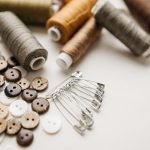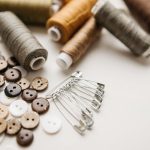So, I've been digging around, trying to clear up a common misconception: is rayon actually 100% cotton? Spoiler alert—it's not. While they both have their cozy spots in our closets, they come from entirely different worlds. Cotton's a natural trooper, straight from the plant, but rayon? It's more of a hybrid, born from wood pulp and a bit of chemical wizardry. They each bring something unique to the table—cotton with its sturdy charm and rayon with its silky touch. But here's where it gets interesting, and I think you'll want to stick around for this part—how do their differences play out in the long run, especially when we talk about sustainability and care?
Table of Contents
Key Takeaways
- Rayon is not 100% cotton; it is a semi-synthetic fabric made from wood pulp.
- Unlike cotton, which is a natural fiber, rayon undergoes chemical processing to achieve its silk-like feel.
- Cotton comes from the cotton plant's seed pods, whereas rayon is sourced from processed cellulose fibers like wood pulp.
- The properties of rayon, including its stretch and drape, differ significantly from the natural characteristics of cotton.
- Rayon and cotton have distinct environmental impacts due to their different sources and manufacturing processes.
Understanding Rayon
Rayon's not just any fabric; it's a semi-synthetic wonder made from wood pulp that feels silky smooth to the touch. Unlike its natural cousin cotton, rayon undergoes a bit of a transformation, thanks to some serious chemical processing. We're talking about wood pulp being dissolved in a cocktail of chemicals like sodium hydroxide and carbon disulfide. This process spins it into the luxurious, silk-like fibers that make rayon stand out in the fabric world.
Now, you might think it's similar to cotton, and you wouldn't be entirely wrong. They both start as plant-based materials, but that's where the similarities end. Rayon's journey through chemical baths gives it that unique, lightweight, and silky texture that cotton just doesn't have. Plus, its ability to hold vibrant colors and drape beautifully? Chef's kiss!
Understanding rayon's semi-synthetic nature is key to appreciating its place in the textile industry. It's not trying to be cotton; it's doing its own thing, bringing a touch of luxury to our wardrobes with its excellent drapability and silky feel. So, next time you're marveling at a smooth, vibrant fabric, chances are, you've got rayon to thank.
The Production of Cotton
So, let's talk about how cotton gets from field to fabric, shall we?
First off, growing cotton is pretty water-hungry and takes a bunch of manual work, not to mention the machines that come into play for picking and processing.
Then there's the environmental side of things, which definitely deserves a look in terms of water use and the impact of all that machinery.
Cotton Cultivation Process
Let's dive into how cotton's grown, starting with planting seeds in nutrient-rich soil, ensuring they get plenty of sunshine and water. Cotton cultivation isn't just about throwing seeds into the ground and hoping for the best. It's a carefully timed process, where the cotton seeds are nurtured into becoming robust plants.
These plants eventually sprout into a shrub-like structure, and that's where the magic happens. The white fluffy bolls that we all recognize start to develop, packed with the cotton fibers we're after.
But hold up, we're not quite at the finish line yet. There's a crucial step before these fibers can be turned into the comfy tee you're wearing – ginning. This is where the seeds are separated from the fibers, prepping them for their next adventure in the world of textiles.
Harvesting and Ginning Cotton
Once the cotton plants are brimming with fluffy bolls, it's time to dive into the harvest and ginning phase, where those bolls get transformed into the raw material for our favorite fabrics. The journey from cotton boll to cozy sweater is fascinating, especially when we look at how ginning plays a pivotal role.
- Picking and Plucking: Grabbing those cotton bolls is the first step, where we get our hands on the raw cotton fibers.
- Ginning: This is where the magic happens, separating seeds and debris from our precious cotton fibers.
- Modern Marvels: Advancements in ginning machinery mean we're doing this faster and more efficiently than ever.
- Quality Control: High-quality ginning ensures our cotton yarns are top-notch.
- From Plant to Premium: It's all about turning those fluffy bolls into premium cotton yarns that we love and trust.
Getting this right is key to crafting the textiles we can't live without.
Environmental Impact Considerations
While we've explored how cotton transforms from boll to yarn, it's important to look at the environmental footprint this process leaves behind. Producing cotton isn't as environmentally friendly as we'd like, given its thirst for water—it takes a whopping 2,700 liters to make just one t-shirt!
Not to mention, the heavy pesticide use isn't doing our ecosystems any favors, contributing to water pollution and harming wildlife. Soil's getting the short end of the stick too, with degradation and biodiversity loss in tow. And let's not forget the carbon footprint; cotton's part of an industry responsible for a significant chunk of global emissions.
However, there's a silver lining with sustainable practices and the pursuit of alternatives like the sustainability of rayon, offering a more eco-conscious choice for lovers of natural fibers.
Key Differences Highlighted
So, let's break down the key differences between rayon and cotton, focusing on their origin and source, fiber properties, and environmental impact.
I've noticed there's a lot of confusion about why they're not the same, especially since they can feel similar.
We'll tackle how they're sourced, what sets their fibers apart, and how each affects the environment, giving you the lowdown to make informed choices.
Origin and Source
I'm diving into the origins and sources of rayon and cotton, which are as different as their textures. Rayon isn't just plucked from a plant; it's a semi-synthetic fabric born from cellulose fibers, primarily wood pulp. This process is way more lab-coat than garden gloves.
On the flip side, cotton is the real deal when it comes to natural fibers, coming straight from cotton bolls.
- Rayon: Born in a lab from wood pulp.
- Cotton: Cultivated from cotton plant seed pods.
- Origin: Cotton has a history spanning thousands of years; rayon's a late 1800s baby.
- Texture: Rayon's silky feel vs. cotton's soft versatility.
- Source: Cellulose fibers for rayon; pure nature for cotton.
Understanding these roots gives us a clearer picture of what we're working with.
Fiber Properties
Diving into the key differences between rayon and cotton, it's clear they're not cut from the same cloth. While rayon fabric, crafted from processed cellulose fibers like wood pulp, mimics the luxurious feel of silk, cotton fabric stays true to its roots, literally. It's all natural, coming straight from cotton plant seed pods.
Rayon fibers bring a bit of stretch and drape that you won't find in cotton, making it a go-to for those slinky, flowy outfits. But when it comes to soaking things up, both are pretty good, though rayon slightly edges out with its superior absorbency. However, cotton wins the durability race, especially when dry, making it a tough contender.
Each has its place, but they're playing different games.
Environmental Impact
When we look at the environmental impact of rayon versus cotton, it's clear there's a big difference between the two.
- Chemical-intensive manufacturing process: Rayon's production is heavy on chemicals, which is a stark contrast to cotton's more natural cultivation.
- Wood pulp sourcing: The environmental impact here varies. Sourcing wood pulp for rayon can lead to deforestation, while cotton is renewable.
- Water usage: Cotton guzzles more water, but rayon isn't off the hook with its own environmental costs.
- Biodegradability: Cotton wins with its natural breakdown, whereas rayon's friendliness to the earth depends on how it's made.
- Sustainability: It boils down to how the raw materials are sourced and the production methods for rayon, making it a mixed bag.
In essence, neither's perfect, but understanding their impacts helps us make better choices.
Durability Comparison
Let's take a closer look at how rayon stacks up against cotton in terms of durability. First off, we gotta understand that these two aren't the same beast. Rayon isn't 100% cotton—it's a semi-synthetic fabric made from processed cellulose fibers.
Now, when it comes to lasting through the hustle and bustle, cotton takes the lead, especially when it's dry. This stuff is tough, making it a go-to for gear that's gotta last.
On the flip side, rayon's a bit of a different story. It's not as sturdy when things get damp or wet. Why's that? Well, it boils down to the nitty-gritty of their fabric structures and properties. Cotton's natural fibers are like the superheroes of durability, while rayon's processed cellulose fibers just can't compete on the same level when moisture enters the mix.
Understanding this durability comparison is super important. It can help you pick the right fabric for what you need, whether that's clothes that'll endure the test of time or something that's a bit more for show than longevity.
Softness and Comfort
I've gotta say, rayon really nails it with the softness and comfort, feeling almost like a second skin. When we talk about what makes our clothes feel good, it's not just about looking sharp; it's that *soft and comfortable* vibe that makes a huge difference. And here's the thing, when you're comparing cotton and rayon, it's a pretty tight race in the comfort department.
- Mimics natural fibers: Rayon's got this knack for feeling as soft and comfy as cotton, making it a go-to for that cozy, cuddle-up feel.
- Luxurious feel: There's something about the way rayon feels on your skin—smooth and luxurious, like you're being pampered.
- Comfortable wearing experience: When it comes to a comfortable feel, rayon doesn't just keep up with cotton; it sets its own standard.
- Soft and gentle touch: The gentle caress of rayon against your skin enhances any garment's comfort level.
- Cozy feel: It's all about that soft and cozy sensation, making rayon a top choice for comfort-seeking fashionistas.
Elasticity and Flexibility
Now, let's talk about how stretchy and flexible these fabrics really are.
I've noticed that rayon tends to bounce back better and handle stress more gracefully than cotton, which is pretty stiff in comparison.
Plus, caring for rayon might need a bit more attention to keep that stretchiness in top shape.
Comparing Fiber Stretch
When comparing the stretchiness of fibers, it's clear that rayon beats cotton, offering more flexibility and a better fit. Dive into what this means:
- Rayon fabrics adapt better to body movements, thanks to their elasticity.
- The stretch differences between rayon and cotton are crucial when you're aiming for comfort without sacrificing style.
- Cotton's rigidity might limit your wardrobe's versatility, especially in pieces meant to drape and flow.
- Elasticity in rayon allows for a variety of garment designs that cotton simply can't match.
- Understanding these properties can guide you in selecting the perfect fabric for your next project, ensuring both comfort and fit.
Durability Under Stress
Let's dive into how rayon and cotton hold up under stress, focusing on their elasticity and flexibility.
Rayon, despite lacking the inherent elasticity that cotton boasts, offers a kind of flexibility that's key for creating a flattering silhouette. It's this flexibility, coupled with its semi-synthetic nature, that allows rayon to outshine cotton in terms of durability under stress.
Cotton, while durable in its own right, just can't compete on the flexibility front, making it more prone to wear and tear when pushed to its limits. Rayon's composition gifts it with superior drapability and movement, allowing it to handle stress with more grace than cotton.
Simply put, rayon's blend of flexibility and durability under stress makes it a tough competitor against natural cotton fibers.
Fabric Care Requirements
Understanding the fabric care requirements for rayon and cotton, especially considering their elasticity and flexibility, is crucial for maintaining their quality and lifespan. Here's the lowdown:
- Rayon's elasticity means it can stretch but doesn't bounce back like synthetic fibers. Handling it gently when wet is key because it's less durable due to the manufacturing process where chemicals are used.
- Cotton's lack of inherent elasticity means it can keep its shape well but isn't as forgiving with movement. It's all about that structured feel.
- Avoid high heat when washing or drying rayon; it can damage the fibers altered during rayon production.
- Cotton, on the other hand, can usually handle a warmer wash, making it a tad easier to care for.
- Always check garment labels for specific care instructions, because sometimes the blend or finish can throw a curveball in your routine.
Absorbency Levels
One key aspect where rayon really shines compared to cotton is in its absorbency levels. Let's dive into why that's the case. It all boils down to rayon's molecular structure and the unique processing methods it undergoes. Unlike cotton, rayon's chemical composition is engineered in such a way that it can suck up moisture like a sponge. This characteristic isn't just a happy accident; it's a deliberate result of how rayon is made.
Now, why does this matter? Well, for starters, rayon's knack for absorbing and releasing moisture quickly makes it a dream for anyone living in or visiting warm climates. You know the feeling of wearing something that just seems to trap all the heat and sweat against your skin? That's less of an issue with rayon. Its high absorbency level plays a big role in keeping you feeling cool and comfortable, even when humidity levels are through the roof.
Despite being a semi-synthetic fiber, rayon manages to closely mimic the best qualities of natural fibers like cotton, especially when it comes to absorbency. This makes it a go-to material for clothing designed to offer relief and comfort in hot and humid conditions.
Wrinkle Resistance
Rayon's knack for staying smooth with minimal effort makes it a standout choice for anyone looking for easy-care clothing. Its natural wrinkle resistance is something I've come to appreciate, especially when I'm rushing out the door and don't have time to iron. Unlike cotton, which I find myself constantly having to smooth out or steam, rayon's inherent properties save me a ton of hassle.
- Wrinkle Resistance: Thanks to its fiber structure, rayon garments keep their polished look without needing much work from me.
- Low-Maintenance Fabric: I'm all for anything that cuts down on my laundry time, and rayon's easy-care nature does just that.
- Smooth Texture: The silky feel of rayon not only looks good; it feels amazing to wear.
- Reduced Ironing Needs: With rayon, I'm not tied to my ironing board. A quick shake out, and I'm good to go.
- Fresh and Neat Appearance: Properly storing my rayon clothes means they're always ready to wear, no wrinkles in sight.
Choosing rayon means embracing a low-maintenance fabric that keeps me looking sharp with minimal effort. Its wrinkle resistance and smooth texture are why it's a staple in my wardrobe.
Sustainability Factors
When considering the environmental impact of our wardrobe choices, it's essential to weigh the sustainability factors of fabrics like rayon against those of cotton. Rayon isn't 100% cotton; it's a semi-synthetic fabric made from processed cellulose fibers. This distinction matters because the sustainability of rayon varies greatly. It's got some perks, like typically needing less water than cotton during production. However, its chemical-intensive production process can't be ignored.
On the flip side, cotton's sustainability depends a lot on how it's grown. Organic cotton, for instance, sidesteps the synthetic pesticides issue, making it a more sustainable choice. But, not all cotton is grown organically, and conventional cotton farming can be pretty water-intensive and chemical-heavy too.
Care and Maintenance
Caring for rayon requires a gentle touch to keep it looking its best. Since it's made from processed cellulose, not 100% cotton, you've gotta treat it a bit differently. Here's the lowdown on how to care for rayon so it stays in tip-top shape:
- Always check the label first. Seriously, those little tags are your best friends.
- Wash it cool. Stick to a max of 30 degrees on a wool or silk program to avoid shrinking.
- Tumble dry with care. A low heat setting is key to maintaining its shape and size without going all wonky on you.
- Iron on the down-low. Low temperature settings are a must to avoid scorching or damaging the fabric.
- Consider handwashing. Sometimes, it's the best way to ensure your rayon garments keep their quality and longevity.
Taking care of rayon isn't rocket science, but it does require a bit of know-how. Remember, gentle is the way to go, whether you're tossing it in the wash, drying, or ironing. Treat it right, and it'll stay looking fresh and fabulous for ages.
Frequently Asked Questions
Which Is Better Rayon or Cotton?
I'd say it depends on what you're after. If you want softness and a silk-like feel, go for rayon. If durability and breathability matter more, then cotton's your best bet. Both have their perks.
Is Cotton or Rayon Better for Summer?
I'd say rayon's better for summer. It's lighter, wicks moisture well, and keeps you cool. Cotton's breathable, sure, but it absorbs sweat and feels heavy. So, for staying comfy and dry, rayon wins hands down.
Does Rayon Shrink Like Cotton?
I've learned that rayon actually shrinks more than cotton, especially when it's wet. It's because of its chemical makeup. So, washing it in cold water and skipping the hot dryer can really help.
Is Rayon a Good Quality Fabric?
I'd say rayon's a pretty good quality fabric. It's got that luxe feel and stays cool, making it a hit for summer wear. Not as tough when wet, but it's a solid choice overall.
- What Are the Main Types of Nonwoven Manufacturing? - July 12, 2025
- Is Fleece a Knit, Woven, or Nonwoven Fabric? - July 12, 2025
- How Nonwoven Technology Is Changing the Textile World - July 12, 2025







